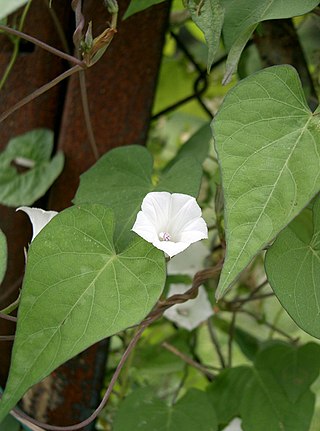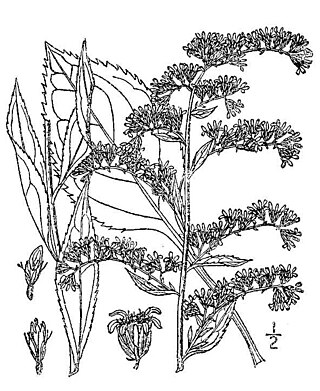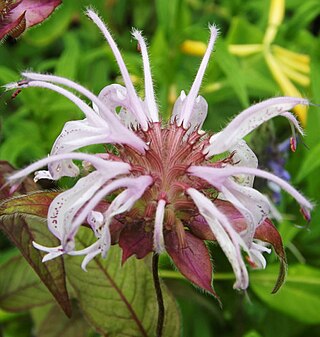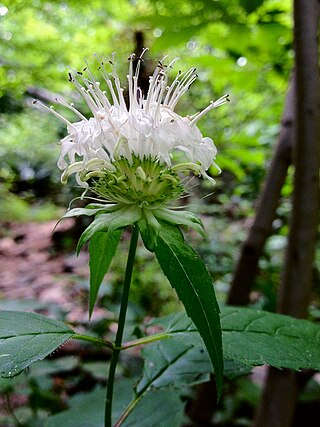
Monarda didyma, the crimson beebalm, scarlet beebalm, scarlet monarda, Eau-de-Cologne plant, Oswego tea, or bergamot, is an aromatic herb in the family Lamiaceae, native to eastern North America from Maine west to Ontario and Minnesota, and south to northern Georgia. Its odor is considered similar to that of the bergamot orange, which is used to flavor Earl Grey tea. The genus name comes from Nicolas Monardes, who described the first American flora in 1569.

Monarda is a genus of flowering plants in the mint family, Lamiaceae. The genus is endemic to North America. Common names include bergamot, bee balm, horsemint, and oswego tea, the first being inspired by the fragrance of the leaves, which is reminiscent of bergamot orange. The genus was named for the Spanish botanist Nicolás Monardes, who wrote a book in 1574 describing plants of the New World.

Echinacea angustifolia, the narrow-leaved purple coneflower or blacksamson echinacea, is a species of flowering plant in the family Asteraceae. It is native to North America, where it is widespread across much of the Great Plains of central Canada and the central United States, with additional populations in surrounding regions.

Grindelia squarrosa, also known as a curly-top gumweed or curlycup gumweed, is a small North American biennial or short-lived perennial plant.

Monarda fistulosa, the wild bergamot or bee balm, is a wildflower in the mint family Lamiaceae, widespread and abundant as a native plant in much of North America. This plant, with showy summer-blooming pink to lavender flowers, is often used as a honey plant, medicinal plant, and garden ornamental. The species is quite variable, and several subspecies or varieties have been recognized within it.

Eurybia hemispherica, commonly known as the southern prairie aster, is an herbaceous plant in the composite family (Asteraceae). It is native to the south-central United States, primarily the lower Mississippi Valley and southeastern Great Plains, from Kansas south to Texas and east to Kentucky, Tennessee, and the Florida Panhandle. Its natural habitat is typically in upland prairies or dry savannas. It is less commonly found in open moist areas, in sandy-loamy soil.

Ambrosia acanthicarpa is a North American species of bristly annual plants in the family Asteraceae. Members of the genus Ambrosia are called ragweeds. The species has common names including flatspine bur ragweed, Hooker's bur-ragweed, annual burrweed, annual bur-sage, and western sand-bur. The plant is common across much of the western United States and in the Prairie Provinces of Canada.

Helianthus grosseserratus, commonly known as sawtooth sunflower or thick-tooth sunflower, is a perennial sunflower in the family Asteraceae, with a large flowering head (inflorescence).

Ipomoea lacunosa, the whitestar, white morning-glory or pitted morning-glory, is a species that belongs to the genus Ipomoea. In this genus most members are commonly referred to as "morning glories". The name for the genus, Ipomoea, has root in the Greek words ips and homoios, which translates to worm-like. This is a reference to the plant's vine-like growth. Lacunosa comes from a Latin word meaning air spaces, correlating with the venation of the leaves. Ipomoea lacunosa is native to the United States and grows annually. The flowers of this species are usually white and smaller than most other morning glories.

Muhlenbergia capillaris, commonly known as the hairawn muhly, is a perennial sedge-like plant that grows to be about 30–90 cm (0.98–2.95 ft) tall and 60–90 cm (2.0–3.0 ft) wide. The plant includes a double layer; green, leaf-like structures surround the understory, and purple-pink flowers outgrow them from the bottom up. The plant is a warm-season grass, meaning that leaves begin growth in the summer. During the summer, the leaves stay green, but they morph during the fall to produce a more copper color. The seasonal changes also include the flowers, as they grow out during the fall and stay healthy till the end of autumn. The muhly grows along the border of roads and on plain prairies. The grass clumps into herds, causing bush-like establishments in the area the hairawn muhly inhabits. The flowers are very feathery and add a cloudlike appearance to the top of the grass. It is native to eastern North America and can be used for a multitude of purposes, including ornamental gardening and farming. It was voted 2012 plant of the year by the Garden Club of America.

Desmodium illinoense, the Illinois ticktrefoil, is a flowering plant in the bean family (Fabaceae), native to the central United States and Ontario, Canada. Illinois ticktrefoil grows in sunny places, such as prairies and oak savannas of the Great Plains and Great Lakes regions.

Sagittaria brevirostra, common name Midwestern arrowhead or shortbeak arrowhead, is an aquatic plant species native to North America. It is common in wet places in an area stretching from Michigan and Ohio south to Alabama and west to North Dakota, Colorado and northern New Mexico, plus isolated populations in Maryland, New Brunswick, Virginia, Saskatchewan and California.

Solidago arguta, commonly called Atlantic goldenrod, cut-leaf goldenrod, and sharp-leaved goldenrod, is a species of flowering plant native to eastern and central North America. It grows along the Gulf and Atlantic states of the United States from Texas to Maine, inland as far as Ontario, Illinois, and Kansas. It is primarily found in areas of woodland openings, such as outcrops or clearings.
Ambrosia grayi, the woollyleaf bur ragweed, is a North American species of plants in the family Asteraceae. It is native to the west-central part of the Great Plains of the United States, in the states of Nebraska, Kansas, Colorado, New Mexico, Oklahoma, and Texas.
Baccharis texana is a North American species of shrubs in the family Asteraceae known by the common name prairie baccharis or false willow. It is native to northeastern Mexico and to the southern part of the Great Plains of the United States.

Solidago radula, the western rough goldenrod, is a North American plant species in the family Asteraceae. It is found primarily in the southern Great Plains and the Mississippi Valley of the United States, with isolated populations farther east in Kentucky, Georgia, and the Carolinas.

Monarda bradburiana, the eastern beebalm or Bradbury's beebalm, is a species of perennial flowering plant in the mint family, Lamiaceae, that is native to much of the southeastern United States.

Dalea multiflora, commonly called roundhead prairie clover, is a species of flowering plant in the legume family (Fabaceae). It is native to North America, where it is found in Mexico and the United States. In the U.S., it is primarily found in the Great Plains and South Central regions. Its natural habitat is in dry rocky prairies, particularly in limestone soils. It is a conservative species and can be indicative of undisturbed prairie communities.

Astragalus crassicarpus, known as ground plum or buffalo plum, is a perennial species of flowering plant in the legume family, Fabaceae, native to North America. It was described in 1813. The fruit is edible and was used by Native Americans as food and horse medicine. It is a host of afranius duskywing larvae. It is also known as groundplum milkvetch and pomme de prairie.

Monarda clinopodia, commonly known as white bergamot, basil bee balm or white bee balm, is a perennial wildflower in the mint family, Lamiaceae. This species is native to North America, ranging north from New York, west to Missouri, and south to Georgia and Alabama. M. clinopodia has also been introduced into Vermont and Massachusetts.


















